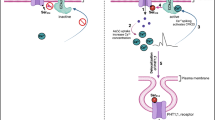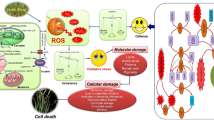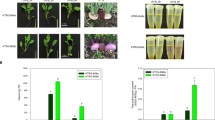Abstract
Ochratoxin A (OTA) is a mycotoxin that is primarily produced by Aspergillus ochraceus and Penicillium verrucosum. This mycotoxin is a contaminant of food and feedstock worldwide and may induce cell death in plants. To investigate the dynamic growth process of Arabidopsis seedlings in response to OTA stress and to obtain a better understanding of the mechanism of OTA toxicity towards Arabidopsis, a comparative proteomics study using 2-DE and MALDI-TOF/TOF MS/MS was performed. Mass spectrometry analysis identified 59 and 51 differentially expressed proteins in seedlings exposed to 25 and 45 μM OTA for 7 days, respectively. OTA treatment decreased root elongation and leaf area, increased anthocyanin accumulation, damaged the photosynthetic apparatus and inhibited photosynthesis. Treatment of the seedlings with 25 μM OTA enhanced energy metabolism, whereas higher concentration of OTA (45 μM) inhibited energy metabolism in the seedlings. OTA treatment caused an increase of ROS, an enhancement of antioxidant enzyme defense responses, disturbance of redox homeostasis and activation of lipid oxidation. Glutamine and S-adenosylmethionine metabolism may also play important roles in the response to OTA. In conclusion, our study provided novel insights regarding the response of Arabidopsis to OTA at the level of the proteome. These results are expected to be highly useful for understanding the physiological responses and dissecting the OTA response pathways in higher plants.







Similar content being viewed by others
References
Abarca ML, Bragulat MR, Castellá G, Cabañes FJ (1994) Ochratoxin A production by strains of Aspergillus niger var. niger. Appl Environ Microbiol 60:2650–2652
Abdalla KO, Rafudeen MS (2012) Analysis of the nuclear proteome of the resurrection plant Xerophyta viscosa in response to dehydration stress using iTRAQ with 2DLC and tandem mass spectrometry. J Proteomics 75:2361–2374
Agrawal GK, Yonekura M, Iwahashi Y, Iwahashi H, Rakwal R (2005) System, trends and perspectives of proteomics in dicot plants. Part III: unraveling the proteomes influenced by the environment, and at the levels of function and genetic relationships. J Chromatogr B 815:137–145
Akhkha A, Clarke DD, Dominy PJ (2003) Relative tolerances of wild and cultivated barley to infection by Blumeria graminis f.sp. hordei (Syn. Erysiphe graminis f.sp. hordei). II: the effects of infection on photosynthesis and respiration. Physiol Mol Plant Pathol 62:347–354
Apel K, Hirt H (2004) Reactive oxygen species: metabolism, oxidative stress, and signal transduction. Annu Rev Plant Biol 55:373–399
Appelhagen I, Lu GH, Huep G, Schmelzer E, Weisshaar B, Sagasser M (2011) TRANSPARENT TESTA1 interacts with R2R3-MYB factors and affects early and late steps of flavonoid biosynthesis in the endothelium of Arabidopsis thaliana seeds. Plant J 67:406–419
Bell E, Creelman RA, Mullet JE (1995) A chloroplast lipoxygenase is required for wound-induced jasmonic acid accumulation in Arabidopsis. Proc Natl Acad Sci 92:8675–8679
Calvo AM, Wilson RA, Bok JW, Keller NP (2002) Relationship between secondary metabolism and fungal development. Microbiol Mol Biol Rev 66:447–459
Canals S, Casarejos MJ, de Bernardo S, Rodríguez-Martín E, Mena MA (2003) Nitric oxide triggers the toxicity due to glutathione depletion in midbrain cultures through 12-lipoxygenase. J Biol Chem 278:21542–21549
Chan Z, Qin G, Xu X, Li B, Tian S (2007) Proteome approach to characterize proteins induced by antagonist yeast and salicylic acid in peach fruit. J Proteome Res 6:1677–1688
Cruz C, Bio AFM, Domínguez-Valdivia MD, Aparicio-Tejo PM, Lamsfus C, Martins-Loução MA (2006) How does glutamine synthetase activity determine plant tolerance to ammonium? Planta 223:1068–1080
Deng A, Tan W, He S, Liu W, Nan T, Li Z, Wang B, Li QX (2008) Monoclonal antibody-based enzyme linked immunosorbent assay for the analysis of jasmonates in plants. J Integr Plant Biol 50:1046–1052
Doyle SM, McCabe PF (2010) Type and cellular location of reactive oxygen species determine activation or suppression of programmed cell death in Arabidopsis suspension cultures. Plant Signal Behav 5:467–468
Egusa M, Ozawa R, Takabayashi J, Otani H, Kodama M (2009) The jasmonate signaling pathway in tomato regulates susceptibility to a toxin-dependent necrotrophic pathogen. Planta 229:965–976
Fang X, Chen W, Xin Y, Zhang H, Yan C, Yu H, Liu H, Xiao W, Wang S, Zheng G, Liu H, Jin L, Ma H, Ruan S (2012) Proteomic analysis of strawberry leaves infected with Colletotrichum fragariae. J Proteomics 75:4074–4090
Finkelstein JD, Martin JJ (2000) Homocysteine. Int J Biochem Cell Biol 32:385–389
Fiorani F, Umbach AL, Siedow JN (2005) The alternative oxidase of plant mitochondria is involved in the acclimation of shoot growth at low temperature. A study of Arabidopsis AOX1a transgenic plants. Plant Physiol 139:1795–1805
Födinger M, Hörl WH, Sunder-Plassmann G (2000) Molecular biology of 5,10-methylenetetrahydrofolate reductase. J Nephrol 13:20–33
Friedel HA, Goa KL, Benfield P (1989) S-adenosyl-l-methionine. A review of its pharmacological properties and therapeutic potential in liver dysfunction and affective disorders in relation to its physiological role in cell metabolism. Drugs 38:389–416
Gechev TS, Gadjev IZ, Hille J (2004) An extensive microarray analysis of AAL-toxin-induced cell death in Arabidopsis thaliana brings new insights into the complexity of programmed cell death in plants. Cell Mol Life Sci 61:1185–1197
Gordon TR, Duniway JM (1982) Effects of powdery mildew infection on the efficiency of CO2 fixation and light utilization by sugar beet leaves. Plant Physiol 69:139–142
Guo G, Ge P, Ma C, Li X, Lv D, Wang S, Ma W, Yan Y (2012) Comparative proteomic analysis of salt response proteins in seedling roots of two wheat varieties. J Proteomics 75:1867–1885
Hossain Z, Makino T, Komatsu S (2012) Proteomic study of β-aminobutyric acid-mediated cadmium stress alleviation in soybean. J Proteomics 75:4151–4164
Huang DW, Sherman BT, Lempicki RA (2008) Systematic and integrative analysis of large gene lists using DAVID bioinformatics resources. Nat Protoc 4:44–57
Konishi H, Yamane H, Maeshima M, Komatsu S (2004) Characterization of fructose-bisphosphate aldolase regulated by gibberellin in roots of rice seedling. Plant Mol Biol 56:839–848
Kubo H, Peeters AJM, Aarts MGM, Pereira A, Koornneef M (1999) ANTHOCYANINLESS2, a homeobox gene affecting anthocyanin distribution and root development in arabidopsis. Plant Cell 11:1217–1226
Li B, Wang W, Zong Y, Qin G, Tian S (2012) Exploring pathogenic mechanisms of Botrytis cinerea secretome under different ambient pH based on comparative proteomic analysis. J Proteome Res 11:4249–4260
Lin SS, Martin R, Mongrand S, Vandenabeele S, Chen KC, Jang IC, Chua NH (2008) RING1 E3 ligase localizes to plasma membrane lipid rafts to trigger FB1-induced programmed cell death in Arabidopsis. Plant J 56:550–561
Marin-Kuan M, Nestler S, Verguet C, Bezençon C, Piguet D, Mansourian R, Holzwarth J, Grigorov M, Delatour T, Mantle P, Cavin C, Schilter B (2006) A toxicogenomics approach to identify new plausible epigenetic mechanisms of ochratoxin a carcinogenicity in rat. Toxicol Sci 89:120–134
Mark Hodges D, Nozzolillo C (1995) Anthocyanin and anthocyanoplast content of cruciferous seedlings subjected to mineral nutrient deficiencies. J Plant Physiol 147:749–754
Masuda D, Ishida M, Yamaguchi K, Yamaguchi I, Kimura M, Nishiuchi T (2007) Phytotoxic effects of trichothecenes on the growth and morphology of Arabidopsis thaliana. J Exp Bot 58:1617–1626
Mathesius U (2009) Comparative proteomic studies of root–microbe interactions. J Proteomics 72:353–366
McNicoll F, Drummelsmith J, Müller M, Madore É, Boilard N, Ouellette M, Papadopoulou B (2006) A combined proteomic and transcriptomic approach to the study of stage differentiation in Leishmania infantum. Proteomics 6:3567–3581
Meyer S, Saccardy AK, Rizza F, Genty B (2001) Inhibition of photosynthesis by Colletotrichum lindemuthianum in bean leaves determined by chlorophyll fluorescence imaging. Plant Cell Environ 24:947–956
Miflin BJ, Habash DZ (2002) The role of glutamine synthetase and glutamate dehydrogenase in nitrogen assimilation and possibilities for improvement in the nitrogen utilization of crops. J Exp Bot 53:979–987
Mitterbauer R, Adam G (2002) Saccharomyces cerevisae and Arabidopsis thaliana: useful model systems for the identification of molecular mechanisms involved in resistance of plants to toxins. Eur J Plant Pathol 108:699–703
Mittova V, Theodoulou FL, Kiddle G, Gómez L, Volokita M, Tal M, Foyer CH, Guy M (2003) Coordinate induction of glutathione biosynthesis and glutathione-metabolizing enzymes is correlated with salt tolerance in tomato. FEBS Lett 554:417–421
Peng XL, Xu WT, Wang Y, Huang KL, Liang ZH, Zhao WW, Luo YB (2010) Mycotoxin Ochratoxin A-induced cell death and changes in oxidative metabolism of Arabidopsis thaliana. Plant Cell Rep 29:153–161
Pitt JI (1987) Penicillium viridicatum, Penicillium verrucosum, and production of ochratoxin A. Appl Environ Microbiol 53:266–269
Qin G, Liu J, Cao B, Li B, Tian S (2011) Hydrogen peroxide acts on sensitive mitochondrial proteins to induce death of a fungal pathogen revealed by proteomic analysis. PLoS ONE 6(7):e21945
Ringot D, Chango A, Schneider Y-J, Larondelle Y (2006) Toxicokinetics and toxicodynamics of ochratoxin A, an update. Chem-Biol Interact 159:18–46
Sappl PG, Carroll AJ, Clifton R, Lister R, Whelan J, Harvey Millar A, Singh KB (2009) The Arabidopsis glutathione transferase gene family displays complex stress regulation and co-silencing multiple genes results in altered metabolic sensitivity to oxidative stress. Plant J 58:53–68
Scheible WR, Fry B, Kochevenko A, Schindelasch D, Zimmerli L, Somerville S, Loria R, Somerville CR (2003) An Arabidopsis mutant resistant to thaxtomin A, a cellulose synthesis inhibitor from Streptomyces species. Plant Cell 15:1781–1794
Stone JM, Heard JE, Asai T, Ausubel FM (2000) Simulation of fungal-mediated cell death by fumonisin B1 and selection of fumonisin B1–resistant (fbr) Arabidopsis mutants. Plant Cell 12:1811–1822
Sun W, Xing B, Sun Y, Du X, Lu M, Hao C, Lu Z, Mi W, Wu S, Wei H, Gao X, Zhu Y, Jiang Y, Qian X, He F (2007) Proteome analysis of hepatocellular carcinoma by two-dimensional difference gel electrophoresis. Mol Cell Proteomics 6:1798–1808
Tohge T, Nishiyama Y, Hirai MY, Yano M, Nakajima J-I, Awazuhara M, Inoue E, Takahashi H, Goodenowe DB, Kitayama M, Noji M, Yamazaki M, Saito K (2005) Functional genomics by integrated analysis of metabolome and transcriptome of Arabidopsis plants over-expressing an MYB transcription factor. Plant J 42:218–235
Van Der Merwe KJ, Steyn PS, Fourie L, Scott DB, Theron JJ (1965) Ochratoxin A, a toxic metabolite produced by Aspergillus ochraceus Wilh. Nature 205:1112–1113
Vellosillo T, Martínez M, López MA, Vicente J, Cascón T, Dolan L, Hamberg M, Castresana C (2007) Oxylipins produced by the 9-lipoxygenase pathway in Arabidopsis regulate lateral root development and defense responses through a specific signaling cascade. Plant Cell 19:831–846
Walters DR, Ayres PG (1984) Ribulose bisphosphate carboxylase protein and enzymes of CO2 assimilation in barley infected by powdery mildew (Erysiphe graminis hordei). J Phytopathol 109:208–218
Wang Y, Peng X, Xu W, Luo Y, Zhao W, Hao J, Liang Z, Zhang Y, Huang K (2011) Transcript and protein profiling analysis of OTA-induced cell death reveals the regulation of the toxicity response process in Arabidopsis thaliana. J Exp Bot 63:2171–2187
Wang YD, Wang X, Wong Y (2012) Proteomics analysis reveals multiple regulatory mechanisms in response to selenium in rice. J Proteomics 75:1849–1866
Xie YJ, Xu S, Han B, Wu MZ, Yuan XX, Han Y, Gu Q, Xu DK, Yang Q, Shen WB (2011) Evidence of Arabidopsis salt acclimation induced by up-regulation of HY1 and the regulatory role of RbohD-derived reactive oxygen species synthesis. Plant J 66:280–292
Xu WT, Peng XL, Luo YB, Wang JA, Guo X, Huang KL (2009) Physiological and biochemical responses of grapefruit seed extract dip on ‘Redglobe’ grape. LWT Food Sci Technol 42:471–476
Yang HR, Tang K, Liu HT, Pan QH, Huang WD (2009) Jasmonic acid is induced in a biphasic manner in response of pea seedlings to wounding. J Integr Plant Biol 51:562–573
Yao X, Xiong W, Ye T, Wu Y (2012) Overexpression of the aspartic protease ASPG1 gene confers drought avoidance in Arabidopsis. J Exp Bot 63:2579–2593
Acknowledgments
We would like to thank all the members of Kunlun Huang’s laboratory who contributed to this project. We also thank the Ministry of Science and acknowledge the mass spectrometry support from the Beijing Proteome Research Center.
Author information
Authors and Affiliations
Corresponding authors
Additional information
Yan Wang and Junran Hao contributed equally to this work.
Electronic supplementary material
Below is the link to the electronic supplementary material.
Rights and permissions
About this article
Cite this article
Wang, Y., Hao, J., Zhao, W. et al. Comparative proteomics and physiological characterization of Arabidopsis thaliana seedlings in responses to Ochratoxin A. Plant Mol Biol 82, 321–337 (2013). https://doi.org/10.1007/s11103-013-0064-x
Received:
Accepted:
Published:
Issue Date:
DOI: https://doi.org/10.1007/s11103-013-0064-x




